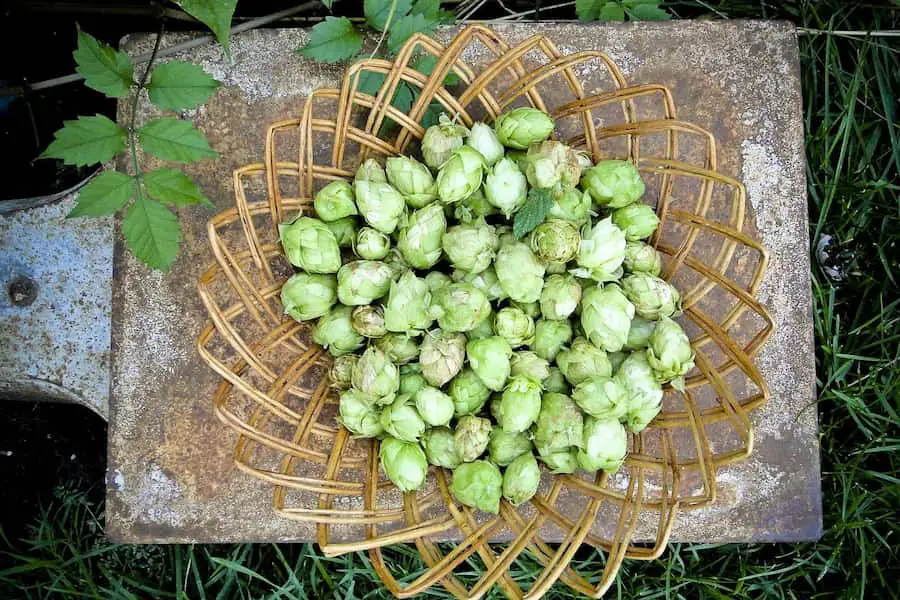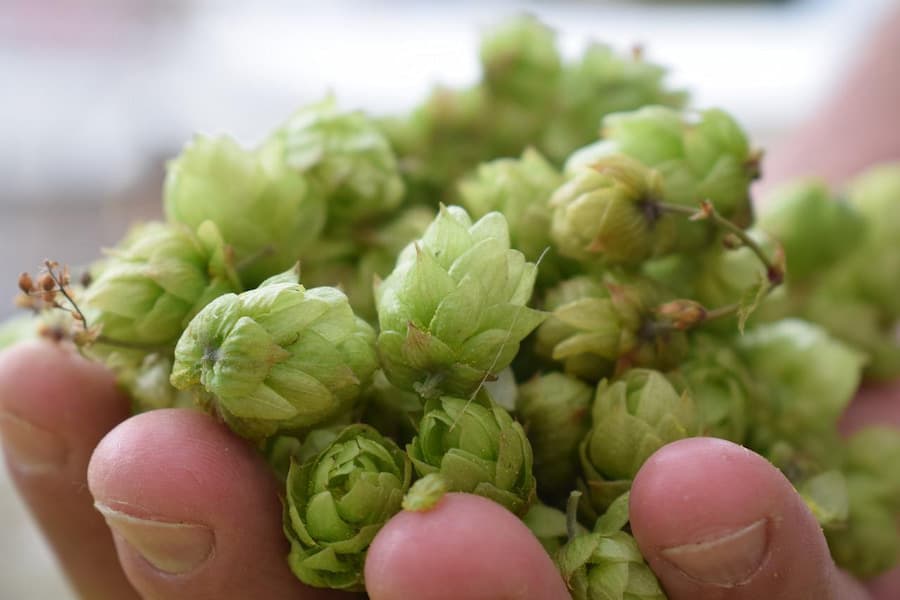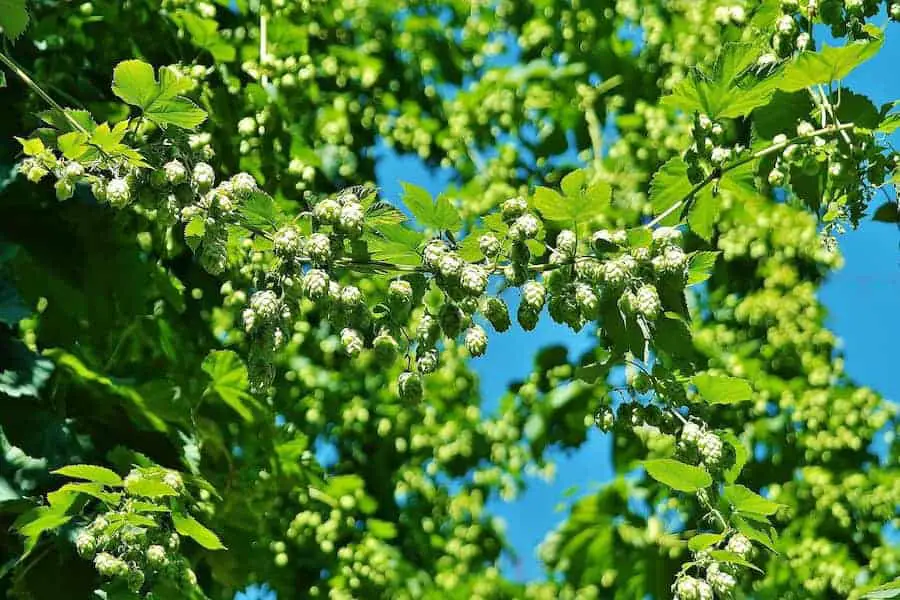If you buy something through a link in our posts, we may get a small share of the sale.
Dry hopping is adding hops to your homebrew during or after fermentation. This is different from adding hops during the boil, which is known as bittering. Understanding how to dry hop in a conical fermenter will help you create an even better-tasting homebrew full of flavour and aroma.
Contents
How to Dry Hop in a Conical Fermenter
To dry hop in a conical fermenter, drop yeast and trub (the solid sediment at the bottom of your fermenter) and pour in your desired amount of hops while swirling the cone around a bit. Swirling helps keep the hops in suspension and prevents them from clumping together and falling to the bottom.
The temperature should be between 60-70F (15-21°C) for dry hopping. Any higher and you risk losing hop aroma; any lower and the process will take longer. You don’t need to worry about oxygenation when hopping in a conical fermenter since the cone allows air to flow in while keeping contaminants out. The yeast will also help prevent oxidation by consuming any oxygen entering the fermenter during the brewing process.
Once you’ve added your hops, put the lid back on and let them steep for 3-7 days before racking (transferring) your beer to a keg or bottling. How much hops to use is determined by the alpha acid content, style of beer, and whether you have used other hops in the boil or for aroma later in the brewing process. A good rule of thumb is 0.5-1.5 ounces (14-42 grams) of hops per 5 gallons (19 L) of homebrew.

How Long Should a Homebrewer Dry Hop?
The duration of the dry-hop addition is generally three to seven days; however, some homebrewers will go as long as two weeks. It really just depends on how much hop aroma and flavor you want in your final product depending on the hops you used.
As the craft beer trend has exploded in recent years, brewers are coming up with new ways of reducing the number of days needed to add hops while still imparting great flavor and aroma. One of these methods is called “whirlpool hopping,” The brewer will add the dry hops after the boil is complete and while the wort is still spinning in the whirlpool.
This allows the hop oils to bind to the trub and be carried out of the brew kettle with it when transferred to the fermenter. The result is a more efficient hop addition that can be as short as 24 hours while still providing great hop character.
Different Types of Dry Hopping
There are different techniques you can apply to ensure that your dry hops provide the best possible results. The following are different types of dry hopping:
Traditional Dry Hopping
It is one of the simplest methods, and all you need to do is add the desired amount of dry hops to your fermenter after primary fermentation is complete. This method works well if you are using pellet hops since they will sink to the bottom of the fermenter and won’t clog the airlock.
When using this method, it’s best to give the fermenter a gentle swirl each day to help keep the hops in suspension and evenly distributed. After three to seven days, rack (transfer) the beer to a keg or bottling bucket, taking care not to disturb the hops too much.

Pros
- It is the simplest method and doesn’t require any special equipment.
- The method works well with pellet hops since they sink to the bottom of the fermenter.
- You don’t have to worry about oxygenation since the fermenter is sealed.
Cons
- It can be hard to evenly distribute the hops in the fermenter.
- You might get a grassy taste if you use too many dry hops.
Whirlpool Dry Hopping
This method is similar to traditional hopping, however, the hops are added to the wort after the boil is complete and while it’s still spinning in the whirlpool. This allows for better hop utilization and can minimize vegetal flavors that are sometimes imparted by hopping.
Pros
- It is a more efficient way to hop since the hops are added directly to the wort.
- There is less of a chance of getting vegetal flavors since the hops are added after the boil.
Cons
- You need to have a whirlpool set up in order to do this method.
- The hops can clog the whirlpool if you’re not careful.
Batch Sparging
Sparging is the process of rinsing the grain after the mash to extract as much sugar as possible. Batch sparging is when you combine all of the wort into one vessel and then sparge (rinse) the grain with water that is the same temperature as the mash.
This method can also be used to hop by adding the hops to the wort before you start sparging. This allows for better contact time between the hops and the wort and can result in a more efficient hop addition.
Pros
- It is a more efficient way to hop since the hops are in contact with the wort for longer.
- The wort is already in one vessel, so there is no need to transfer it.
Cons
- You need to have a large enough vessel to hold all of the wort.
- The wort needs to be well aerated before hopping to ensure good contact between the hops and the wort.

Hop Bag/Ball
This method uses a hop bag or a stainless steel hop ball to contain the hops in one place. You simply add the hops to the bag or ball and place it in the fermenter. This can be done at any time during fermentation as long as the bag or ball is removed before packaging.
Pros
- It is a simple way to add hops to your fermenter since you just need to add the hops to the bag or ball and drop it in.
- The bag or ball can be removed at any time during fermentation to allow for better control over the dry-hop addition.
- You can also hop multiple times by reusing the same bag or ball.
Cons
- You need to have a bag or ball that is big enough to hold all of the hops.
- The bag or ball can add extra vegetal flavors if left in for too long.
Dry Hop Canister
A dry hop canister is a stainless steel container that has a lid with a hole for tubing. It is sometimes referred to as a Hop rocket. The canister is placed in the fermenter, and the hops are added to the canister. This method will require you to have a way to aerate the wort before dry hopping.
Pros
- The material is made from stainless steel so that it won’t impart any flavors to the beer.
- It is a more efficient way to hop since the hops are in contact with the wort for longer.
- You can also hop multiple times by reusing the same canister.
Cons
- You need to have a way to aerate the wort before adding hops.
Frequently Asked Questions
How Do You Dry Hop Without Introducing Oxygen?
The best way to avoid oxidation when dry hopping is to use a vessel that has been purged with CO2. This can be done by flushing the headspace of your fermenter with CO2 before adding the hops, or by using a Hop Gun.
How Long Should I Hop With Pellets?
The ideal dry hop time with pellets is between 2-3 days. This will allow the hops to fully express their flavors and aromas without becoming harsh or grassy.
Conclusion
Dry hopping is a great way to add extra flavor and aroma to your beer. It is important to choose the right method for your beer and to avoid introducing oxygen to the wort. Also, monitor the heat and temperature to avoid making your beer too grassy.

